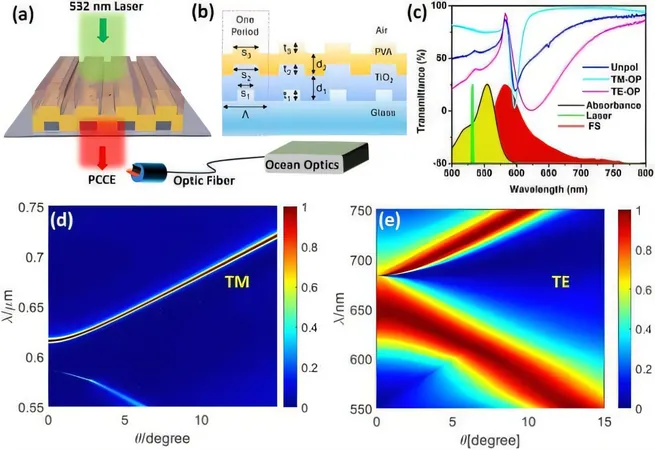
Revolutionary Breakthrough in Biosensing: Manipulating Light at the Nanoscale!
2025-07-01
Author: Wei Ling
From Lab to Life: The Future of Medical Diagnostics
Imagine medical tests no longer requiring lengthy lab waits or hefty costs. Researchers at the Carl R. Woese Institute for Genomic Biology are pushing the boundaries of point-of-care diagnostics, making tests quicker, cheaper, and simpler than ever before.
Nature's Inspiration: The Magic of Peacock Feathers
Ever marveled at the vibrant colors of peacock feathers, changing with the angle of light? This stunning effect isn't due to pigments, but rather to tiny, nanoscopic structures known as photonic crystals. Scientists are now tapping into the power of these structures to enhance biosensing technologies!
Unlocking New Possibilities with Photonic Crystals
The Nanosensors Group at the University of Illinois Urbana-Champaign, spearheaded by Professor Brian Cunningham, has been creating groundbreaking photonic crystal-based biosensors. By using gold nanoparticles to amplify fluorescence, they've opened doors to detecting elusive disease biomarkers. Yet, there’s more work to be done!
Overcoming Limitations: The Quest for Enhanced Sensitivity
Seemesh Bhaskar, a research fellow and lead author, says traditional metal nanoparticles like gold improve fluorescence but also have a downside: they can dim the very signals they're meant to enhance. This flaw creates a detection limit, which the team sought to eliminate.
Innovative Solutions: Enter Cryosoret Nanoassemblies!
In their latest research, published in the MRS Bulletin, the team unveiled a new class of nanoassemblies made from gold nanoparticles, rapidly frozen into organized structures. Bhaskar likens this self-assembly to nature's own designs—from cosmic systems to DNA structures—allowing collective organization for enhanced optical properties.
A Stellar Enhancement: 200-Fold Signal Boost!
By combining these cryosoret nanoassemblies with photonic crystals, the researchers achieved a staggering 200-fold increase in fluorescence signals, significantly reducing the quenching effect and paving the way for ultra-sensitive biomarker detection.
Looking Ahead: Magnetic Tunability for Intelligent Sensors
But they’re not stopping there! The next step is adding magnetic tunability to these nanoassemblies, with hopes of creating smart, responsive biosensing technologies that can adapt to various conditions.
Harnessing the Hidden Power of Light
Unlike many biosensing systems that utilize only the electric side of light, Bhaskar and his team focused on both its electric and magnetic components. Their innovative magneto-plasmonic cryosoret nanoassemblies demonstrated the ability to achieve ultra-sensitive measurements in the attomolar range!
A Game-Changer in Diagnostics!
Cunningham summarizes their work as a hybrid optical platform where light is not just emitted but meticulously orchestrated. This groundbreaking research has enormous potential for the future of medical diagnostics.
Towards a Healthier Future: Next Steps
As they continue to refine their technology, the researchers aim to target critical biomarkers like microRNAs and circulating tumor DNA, heralding a new era of early disease detection—vital for combating cancer and infectious diseases. With their advancements, accessible, sensitive, and portable biosensing systems may soon be a reality!

 Brasil (PT)
Brasil (PT)
 Canada (EN)
Canada (EN)
 Chile (ES)
Chile (ES)
 Česko (CS)
Česko (CS)
 대한민국 (KO)
대한민국 (KO)
 España (ES)
España (ES)
 France (FR)
France (FR)
 Hong Kong (EN)
Hong Kong (EN)
 Italia (IT)
Italia (IT)
 日本 (JA)
日本 (JA)
 Magyarország (HU)
Magyarország (HU)
 Norge (NO)
Norge (NO)
 Polska (PL)
Polska (PL)
 Schweiz (DE)
Schweiz (DE)
 Singapore (EN)
Singapore (EN)
 Sverige (SV)
Sverige (SV)
 Suomi (FI)
Suomi (FI)
 Türkiye (TR)
Türkiye (TR)
 الإمارات العربية المتحدة (AR)
الإمارات العربية المتحدة (AR)